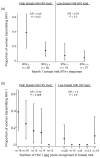Breast milk cellular HIV-specific interferon γ responses are associated with protection from peripartum HIV transmission
- PMID: 22948269
- PMCID: PMC3718292
- DOI: 10.1097/QAD.0b013e328359b7e0
Breast milk cellular HIV-specific interferon γ responses are associated with protection from peripartum HIV transmission
Abstract
Objective: Breast milk is a major route of infant HIV infection, yet the majority of breast-fed, HIV-exposed infants escape infection by unknown mechanisms. This study aimed to investigate the role of HIV-specific breast milk cells in preventing infant HIV infection.
Design: A prospective study was designed to measure associations between maternal breast milk HIV-specific interferon-γ (IFN-γ) responses and infant HIV-1 detection at 1 month of age.
Methods: In a Kenyan cohort of HIV-infected mothers, blood and breast milk HIV-gag IFN-γ ELISpot responses were measured. Logistic regression was used to measure associations between breast milk IFN-γ responses and infant HIV infection at 1 month of age.
Results: IFN-γ responses were detected in breast milk from 117 of 170 (69%) women. IFN-γ responses were associated with breast milk viral load, levels of macrophage inflammatory protein (MIP) 1α, MIP-1β, regulated upon activation, normal T-cell expressed, and secreted and stromal-cell derived factor 1 and subclinical mastitis. Univariate factors associated with infant HIV infection at 1 month postpartum included both detection and breadth of breast milk IFN-γ response (P = 0.08, P = 0.04, respectively), breast milk MIP-1β detection (P = 0.05), and plasma (P = 0.004) and breast milk (P = 0.004) viral load. In multivariate analyses adjusting for breast milk viral load and MIP-1β, breast milk IFN-γ responses were associated with an approximately 70% reduction in infant HIV infection [adjusted odds ratio (aOR) 0.29, 95% confidence interval (CI) 0.092-0.91], and each additional peptide pool targeted was associated with an approximately 35% reduction in infant HIV (aOR 0.65, 95% CI 0.44-0.97).
Conclusion: These data show breast milk HIV-gag-specific IFN-γ cellular immune responses are prevalent and may contribute to protection from early HIV transmission. More broadly, these data suggest breast milk cellular responses are potentially influential in decreasing mother-to-child transmission of viruses.
Conflict of interest statement
There are no conflicts of interest.
Figures



Similar articles
-
Infants with late breast milk acquisition of HIV-1 generate interferon-gamma responses more rapidly than infants with early peripartum acquisition.Clin Exp Immunol. 2009 Jun;156(3):511-7. doi: 10.1111/j.1365-2249.2009.03937.x. Clin Exp Immunol. 2009. PMID: 19438605 Free PMC article.
-
Breast milk HIV-1 RNA levels and female sex are associated with HIV-1-specific CD8+ T-cell responses in HIV-1-exposed, uninfected infants in Kenya.J Infect Dis. 2011 Dec 1;204(11):1806-10. doi: 10.1093/infdis/jir643. Epub 2011 Oct 7. J Infect Dis. 2011. PMID: 21984736 Free PMC article.
-
Maternal Humoral Immune Responses Do Not Predict Postnatal HIV-1 Transmission Risk in Antiretroviral-Treated Mothers from the IMPAACT PROMISE Study.mSphere. 2019 Oct 23;4(5):e00716-19. doi: 10.1128/mSphere.00716-19. mSphere. 2019. PMID: 31645430 Free PMC article. Clinical Trial.
-
Transmission of HIV-1 in the breast-feeding process.J Am Diet Assoc. 1996 Mar;96(3):267-74; quiz 275-6. doi: 10.1016/S0002-8223(96)00079-X. J Am Diet Assoc. 1996. PMID: 8613662 Review.
-
Breast-feeding and Transmission of HIV-1.J Acquir Immune Defic Syndr. 2004 Feb 1;35(2):196-202. doi: 10.1097/00126334-200402010-00015. J Acquir Immune Defic Syndr. 2004. PMID: 14722454 Free PMC article. Review.
Cited by
-
Immunology of pediatric HIV infection.Immunol Rev. 2013 Jul;254(1):143-69. doi: 10.1111/imr.12074. Immunol Rev. 2013. PMID: 23772619 Free PMC article. Review.
-
NK cells from Men Who Have Sex with Men at high risk for HIV-1 infection exhibit higher effector capacity.Sci Rep. 2023 Oct 5;13(1):16766. doi: 10.1038/s41598-023-44054-1. Sci Rep. 2023. PMID: 37798386 Free PMC article.
-
Natural killer cell and T-cell subset distributions and activation influence susceptibility to perinatal HIV-1 infection.AIDS. 2014 May 15;28(8):1115-24. doi: 10.1097/QAD.0000000000000263. AIDS. 2014. PMID: 24752082 Free PMC article.
-
Sex-Related Differences in Inflammatory and Immune Activation Markers Before and After Combined Antiretroviral Therapy Initiation.J Acquir Immune Defic Syndr. 2016 Oct 1;73(2):123-9. doi: 10.1097/QAI.0000000000001095. J Acquir Immune Defic Syndr. 2016. PMID: 27258230 Free PMC article.
-
Mother-to-Child Transmission of HIV Through Breastfeeding Improving Awareness and Education: A Short Narrative Review.Int J Womens Health. 2022 May 13;14:697-703. doi: 10.2147/IJWH.S330715. eCollection 2022. Int J Womens Health. 2022. PMID: 35601795 Free PMC article. Review.
References
-
- Nduati R, John GC, Mbori-Ngacha D, Richardson BA, Overbaugh J, Mwatha A, et al. Effect of breastfeeding and formula feeding on transmission of HIV-1: a randomized clinical trial. JAMA. 2000;283:1167–1174. - PubMed
-
- Hawkes JS, Bryan D-L, Gibson RA. Cytokine production by human milk cells and peripheral blood mononuclear cells from the same mothers. J Clin Immunol. 2002;22:338–344. - PubMed
-
- Ichikawa M, Sugita M, Takahashi M, Satomi M, Takeshita T, Araki T, Takahashi H. Breast milk macrophages spontaneously produce granulocyte-macrophage colony-stimulating factor and differentiate into dendritic cells in the presence of exogenous interleukin-4 alone. Immunology. 2003;108:189–195. - PMC - PubMed
Publication types
MeSH terms
Substances
Grants and funding
LinkOut - more resources
Full Text Sources

